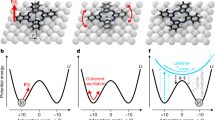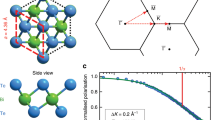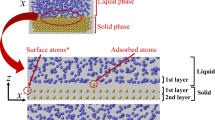Abstract
A nanoscale understanding of the complex dynamics of large molecules at surfaces is essential for the bottom-up design of molecular nanostructures1,2,3,4,5,6,7,8. Here we show that we can change the diffusion coefficient of the complex organic molecule known as Violet Lander (VL, C108H104) on Cu(110) by two orders of magnitude by using the STM at low temperatures to switch between two adsorption configurations that differ only in the molecular orientation with respect to the substrate lattice. From an interplay with molecular dynamics simulations, we interpret the results within a lock-and-key model similar to the one driving the recognition between biomolecules: the molecule (key) is immobilized only when its orientation is such that the molecular shape fits the atomic lattice of the surface (lock); otherwise the molecule is highly mobile.
This is a preview of subscription content, access via your institution
Access options
Subscribe to this journal
Receive 12 print issues and online access
$259.00 per year
only $21.58 per issue
Buy this article
- Purchase on Springer Link
- Instant access to full article PDF
Prices may be subject to local taxes which are calculated during checkout




Similar content being viewed by others
References
Rosei, F. et al. Properties of large organic molecules on metal surfaces. Prog. Surf. Sci. 71, 95–146 (2003).
Rosei, F. et al. Organic molecules acting as templates on metal surfaces. Science 296, 328–331 (2002).
Moresco, F. et al. Probing the different stages in contacting a single molecular wire. Phys. Rev. Lett. 91, 036601 (2003).
Yokoyama, T., Yokoyama, S., Kamikado, T., Okuno, Y. & Mashiko, S. Selective assembly on a surface of supramolecular aggregates with controlled size and shape. Nature 413, 619–621 (2001).
Barth, J. V. et al. Building Supramolecular nanostructures at surfaces by hydrogen bonding. Angew. Chem. Int. Edn Engl. 39, 1230–1234 (2000).
Theobald, J. A., Oxtoby, N. S., Phillips, M. A., Champness, N. R. & Beton, P. H. Controlling molecular deposition and layer structure with supramolecular surface assemblies. Nature 424, 1029–1031 (2003).
Eremtchenko, M., Schaefer, J. A. & Tautz, F. S. Understanding and tuning the epitaxy of large aromatic adsorbates by molecular design. Nature 425, 602–605 (2003).
Gimzewski, J. K. & Joachim, C. Nanoscale science of single molecules using local probes. Science 283, 1683–1688 (1999).
Cai, C. et al. Oblique incidence organic molecular beam deposition and nonlinear optical properties of organic thin films with a stable in-plane directional order. Adv. Mater. 11, 745–749 (1999).
Lang, H. P., Hegner, M., Meyer, E. & Gerber, C. Nanomechanics from atomic resolution to molecular recognition based on atomic force microscopy technology. Nanotechnology 13, R29–R36 (2002).
Weckesser, J., Barth, J. V. & Kern, K. Direct observation of surface diffusion of large organic molecules at metal surfaces: PVBA on Pd(110). J. Chem. Phys. 110, 5351–5354 (1999).
Schunack, M. et al. Long jumps in the surface diffusion of large molecules. Phys. Rev. Lett. 88, 156102 (2002).
Dobbs, K. D. & Doren, D. J. Dynamics of molecular surface diffusion: Energy distributions and rotation–translation coupling. J. Chem. Phys. 99, 10041–10051 (1993).
Lægsgaard, E. et al. A high-pressure scanning tunneling microscope. Rev. Sci. Instrum. 72, 3537–3542 (2001).
Besenbacher, F. Scanning tunnelling microscopy studies of metal surfaces. Rep. Prog. Phys. 59, 1737–1802 (1996).
Horch, S. et al. Enhancement of surface self-diffusion of platinum atoms by adsorbed hydrogen. Nature 398, 134–136 (1999).
Schaub, R. et al. Oxygen-mediated diffusion of oxygen vacancies on the TiO2(110) surface. Science 299, 377–379 (2003).
Gourdon, A. Synthesis of “molecular Landers”. Eur. J. Org. Chem. 2797–2801 (1998).
Zambelli, T. et al. Conformations of a long molecular wire with legs on a Cu(100) surface. Chem. Phys. Lett. 348, 1–6 (2001).
Otero, R. et al. Nanostructuring Cu surfaces using custom-designed molecular molds. Nano Lett. 4, 75–78 (2004).
Legoas, S. B. et al. Molecular-dynamics simulations of carbon nanotubes as gigahertz oscillators. Phys. Rev. Lett. 90, 055504 (2003).
Baughman, R. H. & Galvão, D. S. Crystalline networks with unusual predicted mechanical and thermal properties. Nature 365, 735–737 (1993).
Stryer, L. Biochemistry (Freeman, New York, 1997).
Acknowledgements
We acknowledge financial support from the Danish Ministry for Science, Technology and Innovation through the iNANO Center, from the VELUX foundation and from the EU network 'Manipulation of individual atoms and molecules' (AMNIST). R.O. acknowledges financial support from the EU through a Marie Curie Individual Fellowship. F.S., S.B.L. and D.S.G. acknowledge financial support from the Brazilian Agencies CNPq and FAPESP. We thank A. Gourdon for providing the molecules.
Author information
Authors and Affiliations
Corresponding author
Ethics declarations
Competing interests
The authors declare no competing financial interests.
Rights and permissions
About this article
Cite this article
Otero, R., Hümmelink, F., Sato, F. et al. Lock-and-key effect in the surface diffusion of large organic molecules probed by STM. Nature Mater 3, 779–782 (2004). https://doi.org/10.1038/nmat1243
Received:
Accepted:
Published:
Issue Date:
DOI: https://doi.org/10.1038/nmat1243
This article is cited by
-
Unidirectional motion of C60-based nanovehicles using hybrid substrates with temperature gradient
Scientific Reports (2023)
-
Covalent on-surface polymerization
Nature Chemistry (2020)
-
Peptide Capping Agent Design for Gold (111) Facet by Molecular Simulation and Experimental Approaches
Scientific Reports (2020)
-
How to control single-molecule rotation
Nature Communications (2019)
-
Coupling between diffusion and orientation of pentacene molecules on an organic surface
Nature Materials (2016)



